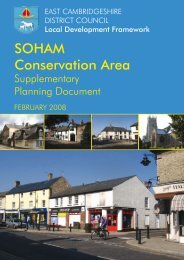- Page 1 and 2: East Cambridgeshire District Counci
- Page 3 and 4: Table of Contents Cambridgeshire Ho
- Page 5 and 6: Executive Summary Stage 2 Water Cyc
- Page 7 and 8: Stage 2 Water Cycle Study: Final Re
- Page 9 and 10: Surface Water Drainage Management S
- Page 11 and 12: SWM5 - Linkages to SWMP and SFRA St
- Page 13 and 14: Glossary of Acronyms and Abbreviati
- Page 15 and 16: Abbreviation Description RTPI Royal
- Page 17 and 18: 1.3 Stage 2 - Study Governance Stag
- Page 19 and 20: Stage 2 Water Cycle Study: Final Re
- Page 21 and 22: • Surface Water Management Plan f
- Page 23 and 24: 2 Proposed Growth 2.1 Preferred Gro
- Page 25 and 26: 2.3 Employment Stage 2 Water Cycle
- Page 27: Figure 2-1: Potential development s
- Page 31 and 32: Stage 2 Water Cycle Study: Final Re
- Page 33 and 34: WwTW Soham Burwell Bottisham Hadden
- Page 36 and 37: 3.2.2 Results Discussion WwTW Soham
- Page 38 and 39: WwTW Consent parameter Stage 2 Wate
- Page 40 and 41: Stage 2 Water Cycle Study: Final Re
- Page 42 and 43: Stage 2 Water Cycle Study: Final Re
- Page 44 and 45: Stage 2 Water Cycle Study: Final Re
- Page 46 and 47: Table 3-7: Potential Impact of Clim
- Page 48 and 49: 3.3 Ecological Appraisal Stage 2 Wa
- Page 50 and 51: Stage 2 Water Cycle Study: Final Re
- Page 52 and 53: Stage 2 Water Cycle Study: Final Re
- Page 54 and 55: Stage 2 Water Cycle Study: Final Re
- Page 56 and 57: Stage 2 Water Cycle Study: Final Re
- Page 58 and 59: Stage 2 Water Cycle Study: Final Re
- Page 60 and 61: 3.4.1 Stage 2 network assessment re
- Page 62 and 63: Site Description of potential waste
- Page 64 and 65: Site Description of potential waste
- Page 66 and 67: Bottisham Site Assessment Site Desc
- Page 68 and 69: Stage 2 Water Cycle Study: Final Re
- Page 70 and 71: Impact on Supplies Stage 2 Water Cy
- Page 72 and 73: Stage 2 Water Cycle Study: Final Re
- Page 74 and 75: Stage 2 Water Cycle Study: Final Re
- Page 76 and 77: Low flow taps and showers Stage 2 W
- Page 78 and 79:
Stage 2 Water Cycle Study: Final Re
- Page 80 and 81:
Figure 4-1: A typical domestic rain
- Page 82 and 83:
Stage 2 Water Cycle Study: Final Re
- Page 84 and 85:
Medium Scenario The key assumptions
- Page 86 and 87:
Table 4-7: Details of new Build Spe
- Page 88 and 89:
WN Scenario New development Water u
- Page 90 and 91:
Operation of GWR £30 per annum 82
- Page 92 and 93:
Table 4-12: Estimated Cost of Neutr
- Page 94 and 95:
Figure 4-3: CO2 emissions from a
- Page 96 and 97:
Stage 2 Water Cycle Study: Final Re
- Page 98 and 99:
4.4.7 Preferred strategy - delivery
- Page 100 and 101:
Stage 2 Water Cycle Study: Final Re
- Page 102 and 103:
Stage 2 Water Cycle Study: Final Re
- Page 104 and 105:
5 Surface Water Management 5.1 The
- Page 106 and 107:
Stage 2 Water Cycle Study: Final Re
- Page 108 and 109:
• continuous surfaces with an inh
- Page 110 and 111:
Stage 2 Water Cycle Study: Final Re
- Page 112 and 113:
5.5.1 Ecological opportunities Ely
- Page 114 and 115:
Site Stage 2 Water Cycle Study: Fin
- Page 116 and 117:
Stage 2 Water Cycle Study: Final Re
- Page 118 and 119:
5.5.7 SuDS and groundwater protecti
- Page 120 and 121:
Stage 2 Water Cycle Study: Final Re
- Page 122 and 123:
Stage 2 Water Cycle Study: Final Re
- Page 124 and 125:
Stage 2 Water Cycle Study: Final Re
- Page 126 and 127:
Lisle Lane, Ely 2.855 2.28 1,038 -
- Page 128 and 129:
Land rear of Fordham Road, Soham 2.
- Page 130 and 131:
6.3.3 Wastewater Network constraint
- Page 132 and 133:
6.4.4 Phasing Assessment Phase Dwel
- Page 134 and 135:
Stage 2 Water Cycle Study: Final Re
- Page 136 and 137:
7.2 Climate Change and the Water Cy
- Page 138 and 139:
Stage 2 Water Cycle Study: Final Re
- Page 140 and 141:
Stage 2 Water Cycle Study: Final Re
- Page 142 and 143:
Directive/Legislation/Guidance Desc
- Page 144 and 145:
Key Additional development can be a
- Page 146 and 147:
Consents to achieve ‘Good Status
- Page 148 and 149:
MASS BALANCE CALCULATION: MONTE CAR
- Page 150 and 151:
MASS BALANCE CALCULATION: MONTE CAR
- Page 152 and 153:
MASS BALANCE CALCULATION: MONTE CAR
- Page 154 and 155:
MASS BALANCE CALCULATION: MONTE CAR
- Page 156 and 157:
MASS BALANCE CALCULATION: MONTE CAR
- Page 158 and 159:
MASS BALANCE CALCULATION: MONTE CAR
- Page 160 and 161:
MASS BALANCE CALCULATION: MONTE CAR
- Page 162 and 163:
MASS BALANCE CALCULATION: MONTE CAR
- Page 164 and 165:
Stage 2 Water Cycle Study: Final Re
- Page 166 and 167:
LITTLEPORT STW Current Quality Cons
- Page 168 and 169:
HADDENHAM STW Current Quality Conse
- Page 170:
Stage 2 Water Cycle Study: Final Re
- Page 173 and 174:
Stage 2 Water Cycle Study: Final Re
- Page 175 and 176:
Sequencing Batch Reactor Stage 2 Wa
- Page 177 and 178:
Tertiary treatment Stage 2 Water Cy
- Page 179 and 180:
East Cambridgeshire WCS Flood Estim
- Page 181 and 182:
East Cambridgeshire WCS Flood Estim
- Page 183 and 184:
East Cambridgeshire WCS Flood Estim
- Page 185 and 186:
East Cambridgeshire WCS Flood Estim
- Page 187 and 188:
East Cambridgeshire WCS Flood Estim
- Page 189 and 190:
East Cambridgeshire WCS Flood Estim
- Page 191 and 192:
East Cambridgeshire WCS Flood Estim
- Page 193 and 194:
East Cambridgeshire WCS Flood Estim
- Page 195 and 196:
East Cambridgeshire WCS Flood Estim
- Page 197 and 198:
East Cambridgeshire WCS Flood Estim
- Page 199 and 200:
East Cambridgeshire WCS Flood Estim
- Page 201 and 202:
East Cambridgeshire WCS Flood Estim
- Page 203 and 204:
East Cambridgeshire WCS Flood Estim
- Page 205 and 206:
East Cambridgeshire WCS Flood Estim
- Page 207 and 208:
East Cambridgeshire WCS Flood Estim
- Page 209 and 210:
East Cambridgeshire WCS Flood Estim
- Page 211 and 212:
Stage 2 Water Cycle Study: Final Re
- Page 213 and 214:
11 12 12 Is the discharged water on
- Page 215 and 216:
37 38 40 41 42 A) Have you provided
- Page 217 and 218:
Stage 2 Water Cycle Study: Final Re
- Page 219 and 220:
Stage 2 Water Cycle Study: Final Re
- Page 221:
Stage 2 Water Cycle Study: Final Re






